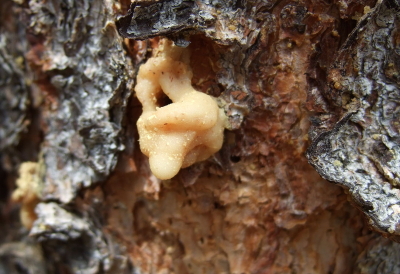Mountain Pine Beetle Facts
Mountain pine beetles are Colorado natives that mostly infest a variety of pines, including the ponderosa, the lodgepole and the limber pine trees. Even ornamental pines can be affected when the

Pine beetle pitch tube
beetle populations rise to high levels.
It takes only a year for a beetle to go from egg to adult, usually looking for a new host between July and August. Some will emerge from their initial host trees in the earlier or later summer periods, with the females usually preferring the larger trees when possible.
Knowing You Have Mountain Pine Beetles
Another Mountain pine beetle facts is that it causes significant damage to trees but they are difficult to see. You’ll need to look out for the physical signs or symptoms on the tree, including the rusty colored needles. These needles usually drop from the trees a year after infestation, because the trees can’t pass the nourishment around. The beetles’ tunnels prevent the spread of nutrients.
You may also see the boring marks as beetles have dug their way in. These marks usually appear on the lower bark, close to the ground. As the beetles tunnel, you may also see the pitch tubes, which can be white, brown, or pink. Exit holes can also form during the summer months.
Woodpeckers like to eat the larvae, so you can often see higher than normal woodpecker damage.
Managing Mountain Pine Beetles
One of the best ways to get rid of the pests is to remove the infested trees. It’s possible to use a tree as a trap, encouraging the beetles to swarm to it and then remove it right away. This gets rid of the problem from the source. Solar treatments are popular, especially in areas that are small. Once the trees are infested, they’re covered in clear plastic to create heat in the sun that makes it unbearable for the larvae.
If you suspect your trees are infested with mountain pine beetles, give SprayTech a call on tree protecting your trees from further mountain pine beetle attacks.

